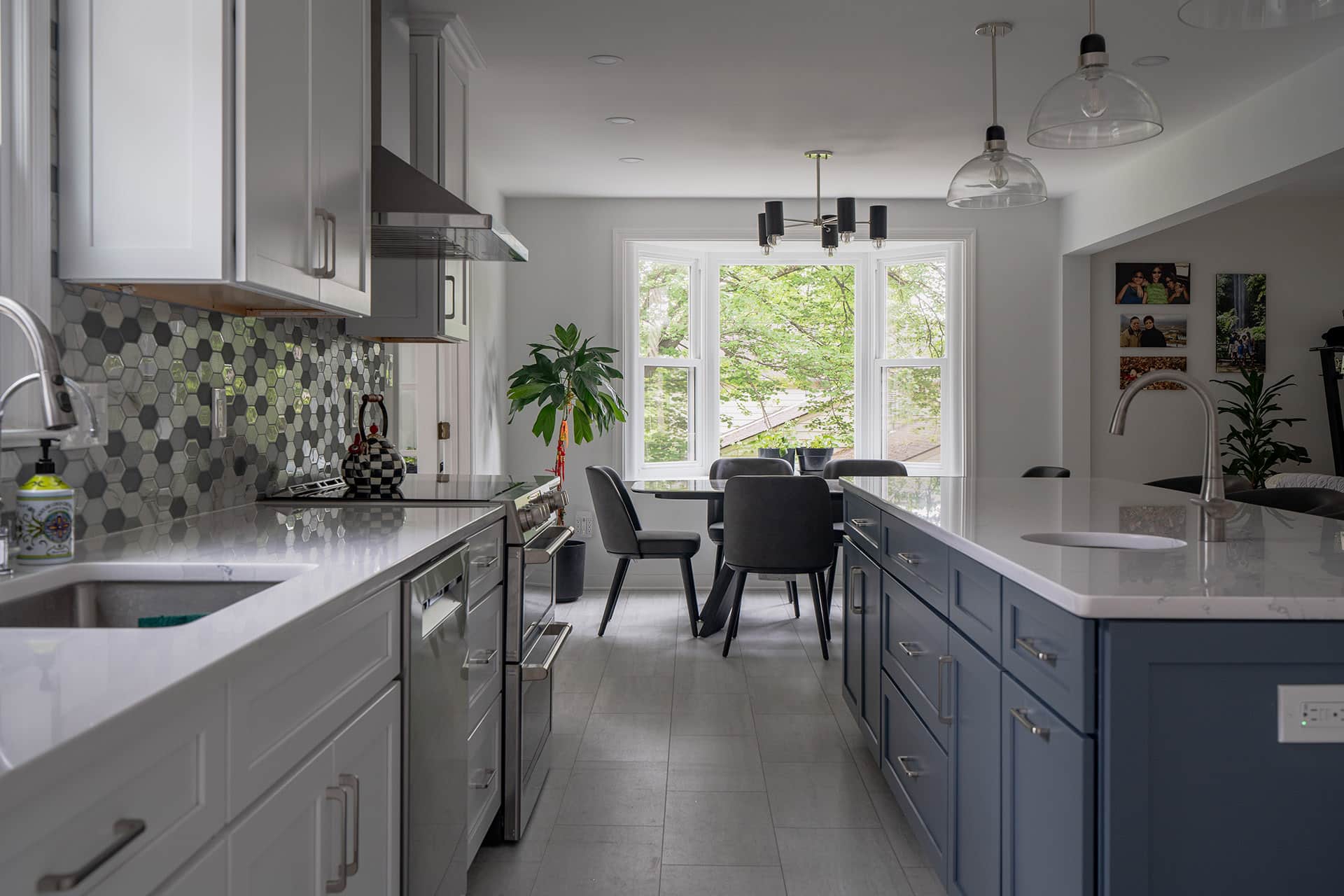Kitchen and bathroom flooring plays a crucial role in both the aesthetics and functionality of your home. These areas are high-traffic and moisture-prone, requiring flooring that can withstand daily wear while maintaining its appeal. The right flooring can elevate the design of your kitchen and bathroom, making them not only beautiful but also practical. This guide is designed to help you make informed decisions about kitchen and bathroom flooring based on your needs, preferences, and budget.

Factors to Consider When Choosing Flooring
Durability
When it comes to kitchen and bathroom flooring, durability is key. These spaces experience frequent use, so it’s important to choose materials that can handle heavy foot traffic and resist wear and tear over time.
Water and Moisture Resistance
Since kitchens and bathrooms are exposed to water and humidity, selecting flooring with excellent moisture resistance is essential. Different materials react differently to water, so understanding this will help you avoid issues like warping, mold, and stains.
Ease of Cleaning and Maintenance
In kitchens and bathrooms, hygiene is a top priority. Flooring that is easy to clean and maintain will ensure that your spaces remain sanitary and safe. Consider how often the flooring needs to be cleaned and what methods are required to keep it in top condition.
Aesthetics and Style
Your choice of flooring should complement the overall design of your kitchen and bathroom. Whether you prefer a modern look or something more traditional, matching the flooring to your style is crucial. Keep an eye on current trends in kitchen and bathroom flooring to ensure your choices are up-to-date and stylish.

Popular Flooring Options for Kitchens
A. Tile Flooring
- Types: Ceramic, Porcelain, Natural Stone
- Pros: Highly durable, water-resistant, wide variety of styles
- Cons: Can be cold underfoot, requires regular grout maintenance
- Cost: $3 to $12 per square foot, depending on the material and design

B. Vinyl Flooring
- Types: Sheet Vinyl, Luxury Vinyl Tiles (LVT), Luxury Vinyl Planks (LVP)
- Pros: Water-resistant, easy to install, affordable
- Cons: Can be less durable than tile, potential for wear over time
- Cost: $1 to $6 per square foot, varying by type

C. Hardwood Flooring
- Types: Engineered vs. Solid Hardwood
- Pros: Timeless appeal, can be refinished multiple times
- Cons: Susceptible to moisture damage, higher maintenance
- Cost: $5 to $15 per square foot, depending on the type and finish

D. Laminate Flooring
- Pros: Affordable, easy to install, mimics the look of hardwood
- Cons: Not as durable as real wood, susceptible to moisture damage
- Cost: $2 to $5 per square foot, offering good value for money

E. Concrete Flooring
- Types: Polished and stained concrete
- Pros: Extremely durable, customizable with stains and finishes
- Cons: Can be hard underfoot, requires professional installation
- Cost: $2 to $8 per square foot, depending on the complexity of the finish

Popular Flooring Options for Bathrooms
A. Tile Flooring
- Focus: Moisture resistance
- Pros: Slip-resistant options available, highly durable
- Cons: Cold underfoot, grout may need regular cleaning
- Cost: $3 to $12 per square foot, varying by material and design

B. Vinyl Flooring
- Popularity: Excellent waterproofing, ideal for bathrooms
- Pros: Affordable, comfortable underfoot, easy to clean
- Cons: Can be less durable than other options over time
- Cost: $1 to $6 per square foot, offering long-term value

C. Natural Stone Flooring
- Types: Marble, Granite, Slate
- Pros: Luxurious appearance, very durable
- Cons: High maintenance, premium pricing
- Cost: $10 to $30 per square foot, including installation costs

D. Waterproof Laminate
- Pros: Newer options provide waterproofing, looks like wood
- Cons: Can be more expensive than standard laminate
- Cost: $3 to $7 per square foot, comparing favorably with other options

E. Cork Flooring
- Pros: Soft, warm underfoot, natural insulation properties
- Cons: Prone to scratches and dents, needs sealing
- Cost: $2 to $12 per square foot, including additional maintenance expenses
Installation Considerations
Professional vs. DIY Installation
Professional installation often ensures a higher-quality finish but comes at a higher cost, typically ranging from $3 to $12 per square foot, depending on the material and labor involved. DIY installation can save money, with costs limited to materials and tools, but may require more time and effort, and the results might not match the quality of professional work.
Preparation and Subfloor Requirements
Proper subfloor preparation is crucial for the longevity of your kitchen and bathroom flooring. Depending on the material, you may need specific underlayment options to provide soundproofing, insulation, and moisture barriers.
Maintenance Post-Installation
Once your flooring is installed, ongoing maintenance is essential to keep it looking its best. Different materials require different care, such as sealing, resealing, and polishing, to maintain their appearance and functionality.

Selecting the right kitchen and bathroom flooring involves considering various factors, from durability and moisture resistance to aesthetics and installation. By understanding the strengths and weaknesses of each flooring option, you can choose the best one that suits your lifestyle and budget. When in doubt, consult with a flooring expert to ensure you make the most informed decision.
